野火指南者(STM32F103VET6)應用:實現USB虛擬串列埠(CDC_VPC)
MCU:STM32F103VET6
開發環境:STM32CubeMX+MDK5
實現USB的虛擬串列埠不需要去理解USB的底層驅動,只需要STM32CubeMX去設定生成工程即可。在野火的指南者中,是沒有這一類的視訊和範例的,博主使用這款開發板實現USB虛擬串列埠。
首先需要開啟STM32CubeMX工具。輸入開發板MCU對應型號,找到開發板對應封裝的MCU型號,雙擊開啟(圖中第三)。
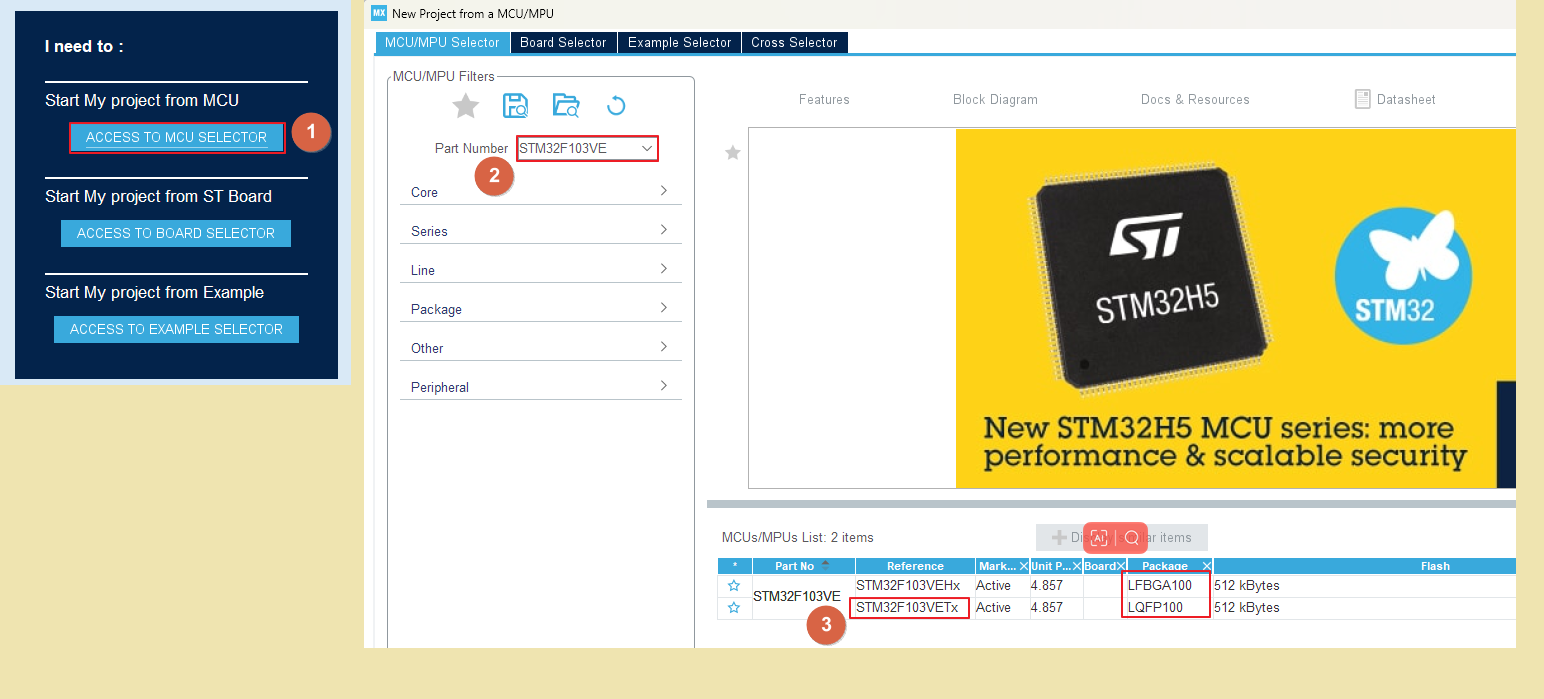
此時,雙擊完後會關閉此介面,然後開啟一個新介面。

然後,我們開始基本設定。

現在我們選擇一個LED作為系統LED,該步驟可以忽略,只是本人喜歡這樣子。以硬體原理圖的綠燈為例子。
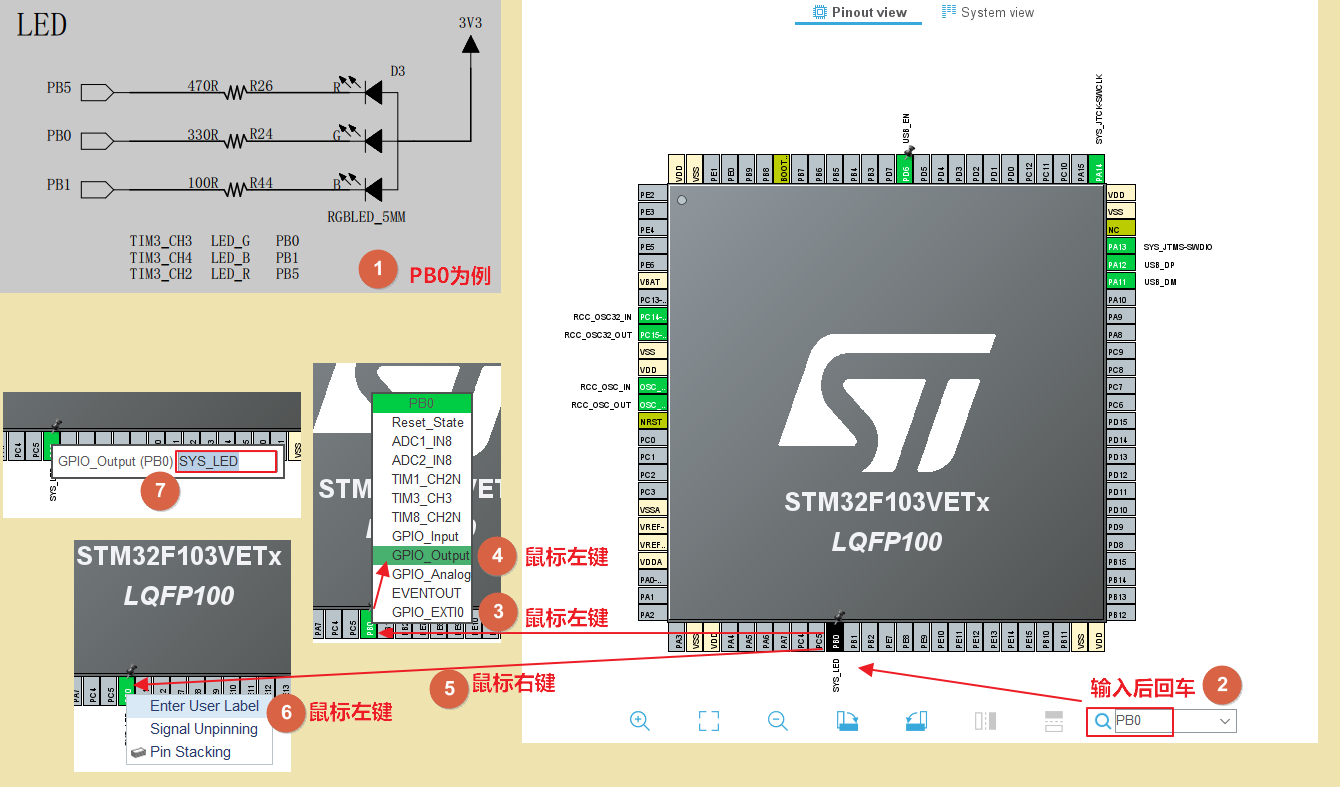
基本設定除了時鐘樹外,基本上已經設定好了。
現在來設定USB_Device。STM32F1系列USB只支援USB_Device。
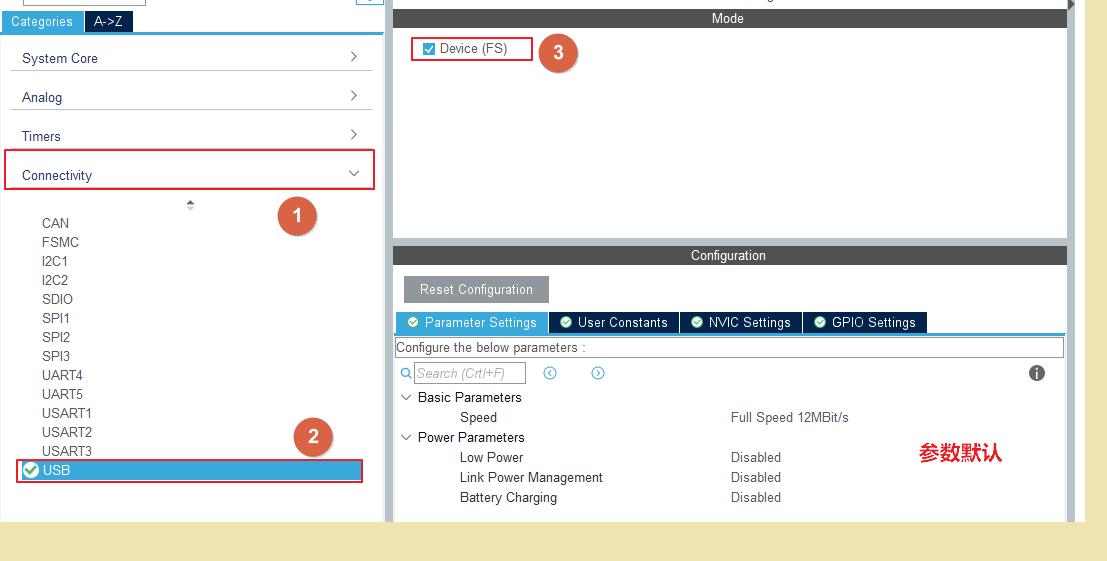
選中USB型別後,還需要細化其中的型別。
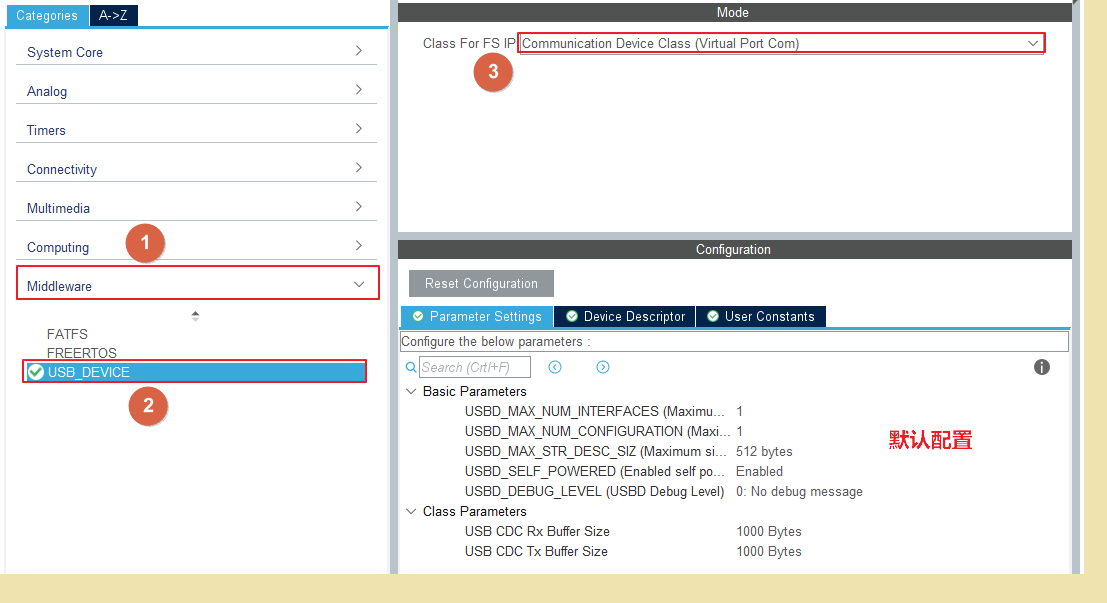
一切設定都是基於硬體原理圖的。硬體設定除常規設定外,還是需要看硬體原理圖的。在硬體原理圖中,可以看到只有PD6拉低時,USB才使能。(針對野火指南者開發板)
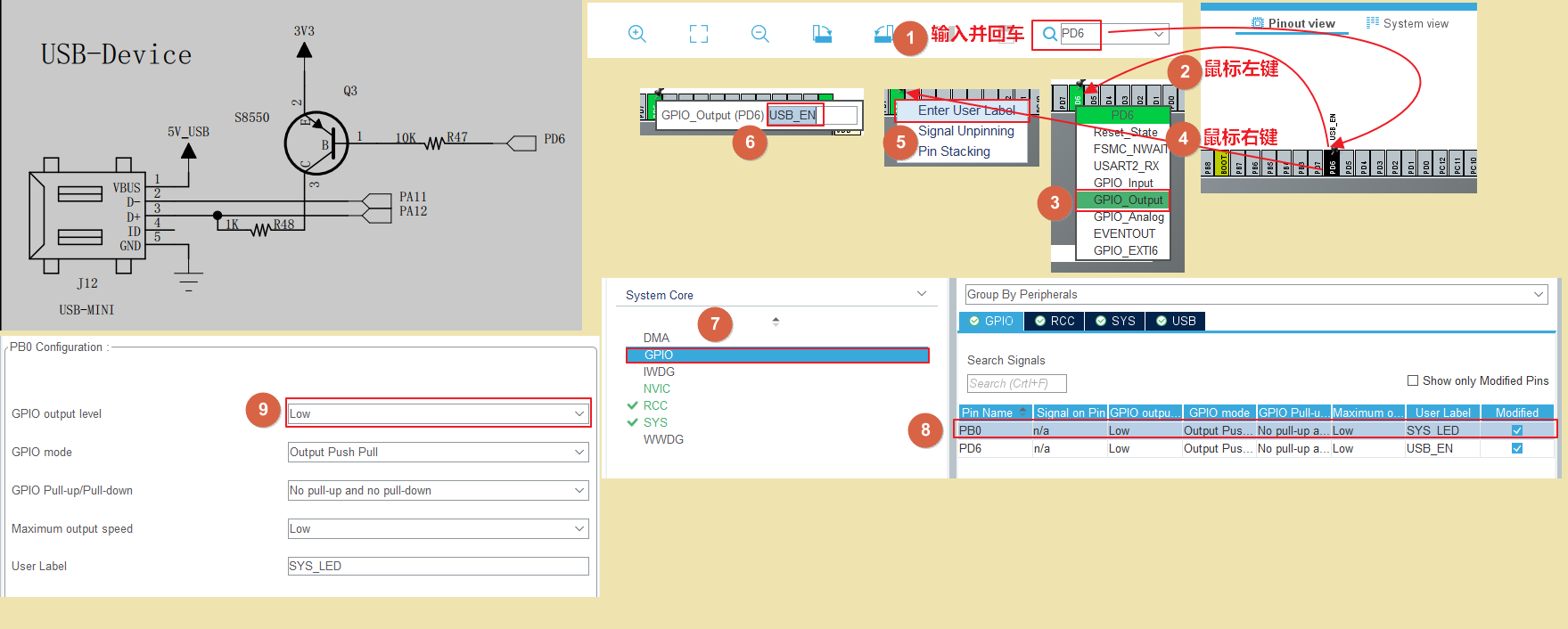
現在設定時鐘樹
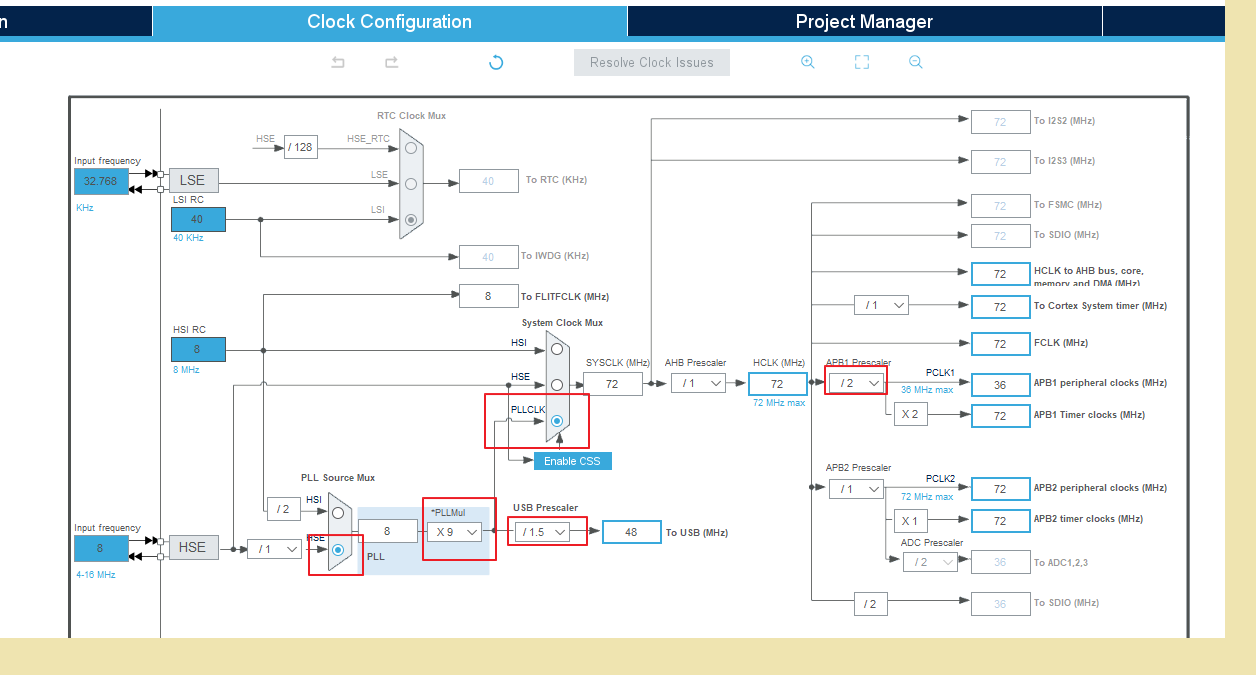
設定完成,完善工程,生成工程。
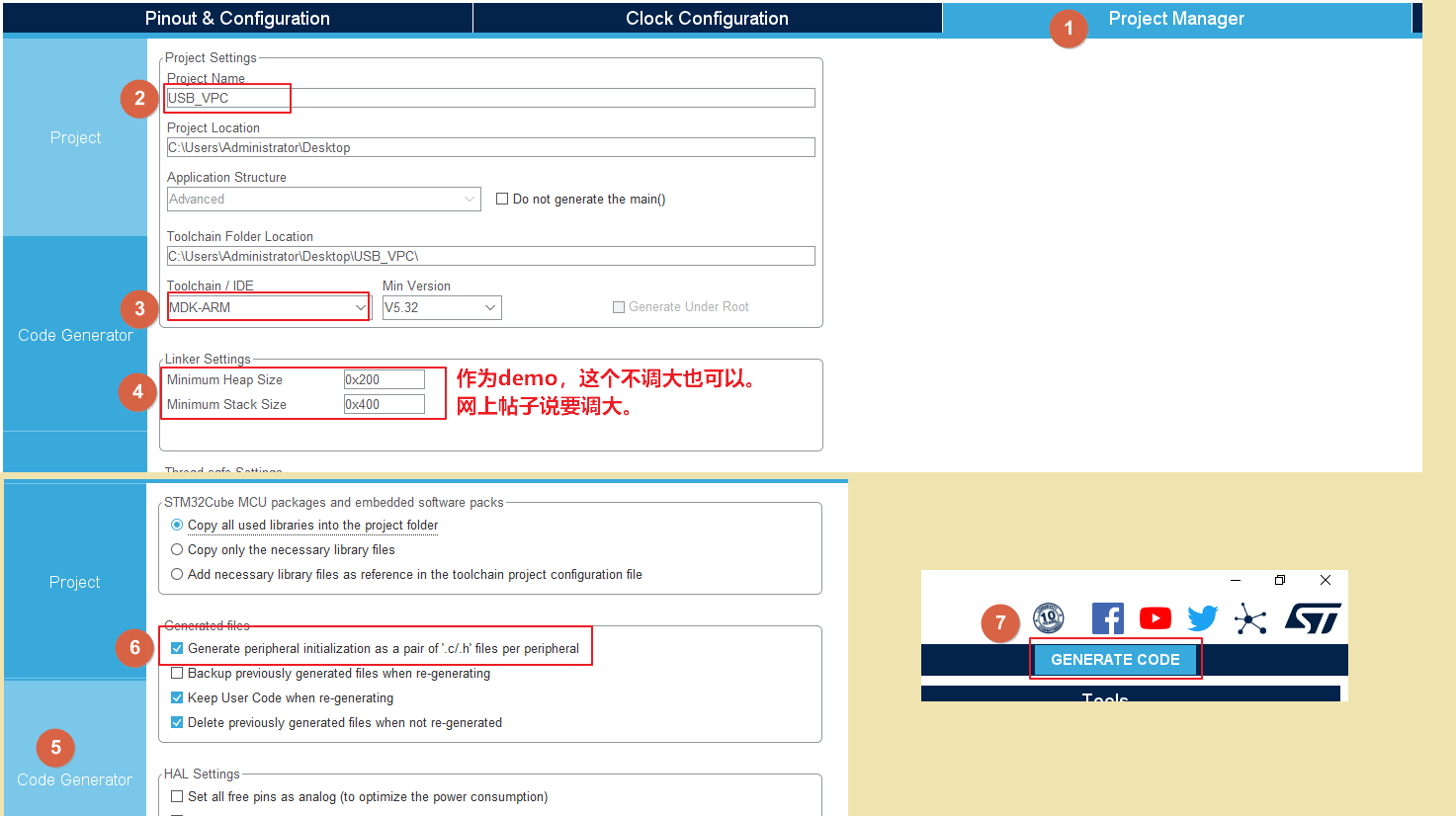
到此,STM32CubeMX工具的使用結束!可以發現在桌面已經生成了USB_VPC工程。
USB虛擬串列埠還需要裝驅動才能被是識別到,在Win7、Win8機型PC中需要到ST官網下載。win10及以上機型在本地已有驅動,無需安裝。
使用MDK5開啟USB_VPC工程開啟。點選魔法棒,勾選微庫。選擇對應的下載器,勾選下載完復位允許。USB線一端接開發板USB_Device,一端接PC。
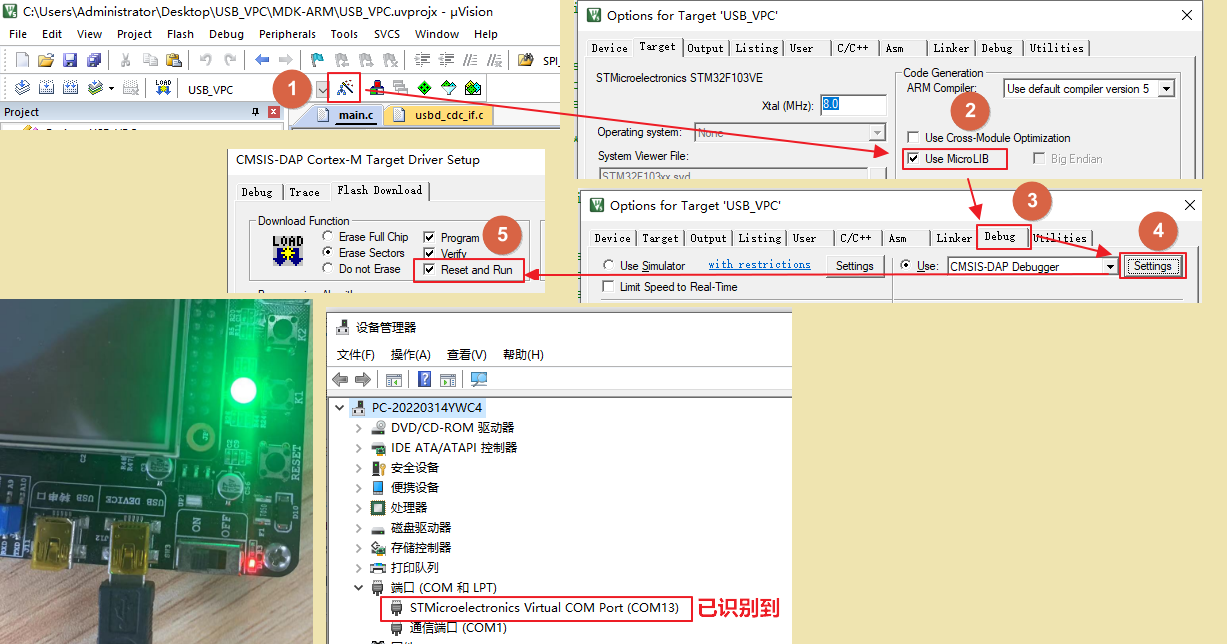
現在可以開始實驗了,實現VPC的傳送與回傳,並重定向printf函數。
在此之前,簡單描述一下生成的USB檔案以及重要函數。

然後再插播一條,看貼文說是,剛下載完程式時,是識別不出埠的。需要在上電的情況下從PC那拔插一次USB線。然後可以使用一個函數解決這個問題。可以在gpio.c中寫入函數,然後記得在標頭檔案宣告。使用要在MX_USB_DEVICE_Iint()之前。
(我沒遇到這個問題,但是我還是放到工程了,但是我沒用這函數。)
1 /* USER CODE BEGIN 2 */ 2 /*USB 重新列舉函數*/ 3 void USB_Reset(void) 4 { 5 GPIO_InitTypeDef GPIO_InitStruct = {0}; 6 7 __HAL_RCC_GPIOA_CLK_ENABLE(); 8 9 GPIO_InitStruct.Pin = GPIO_PIN_12; 10 GPIO_InitStruct.Mode = GPIO_MODE_OUTPUT_PP; 11 GPIO_InitStruct.Pull = GPIO_NOPULL; 12 GPIO_InitStruct.Speed = GPIO_SPEED_FREQ_LOW; 13 HAL_GPIO_Init(GPIOA, &GPIO_InitStruct); 14 15 HAL_GPIO_WritePin(GPIOA,GPIO_PIN_12,GPIO_PIN_RESET); 16 HAL_Delay(100); 17 HAL_GPIO_WritePin(GPIOA,GPIO_PIN_12,GPIO_PIN_SET); 18 } 19 /* USER CODE END 2 */
實驗環節:傳送與回傳
在main.c中(擷取片段,修改部分)
1 /* Private includes ----------------------------------------------------------*/ 2 /* USER CODE BEGIN Includes */ 3 #include "usbd_cdc_if.h" 4 /* USER CODE END Includes */ 5 6 /* Private typedef -----------------------------------------------------------*/ 7 /* USER CODE BEGIN PTD */ 8 9 /* USER CODE END PTD */ 10 11 /* Private define ------------------------------------------------------------*/ 12 /* USER CODE BEGIN PD */ 13 /* USER CODE END PD */ 14 15 /* Private macro -------------------------------------------------------------*/ 16 /* USER CODE BEGIN PM */ 17 18 /* USER CODE END PM */ 19 20 /* Private variables ---------------------------------------------------------*/ 21 22 /* USER CODE BEGIN PV */ 23 24 /* USER CODE END PV */ 25 26 /* Private function prototypes -----------------------------------------------*/ 27 void SystemClock_Config(void); 28 /* USER CODE BEGIN PFP */ 29 30 /* USER CODE END PFP */ 31 32 /* Private user code ---------------------------------------------------------*/ 33 /* USER CODE BEGIN 0 */ 34 35 /* USER CODE END 0 */ 36 37 /** 38 * @brief The application entry point. 39 * @retval int 40 */ 41 int main(void) 42 { 43 /* USER CODE BEGIN 1 */ 44 char str[] = "Hello World!\r\n"; 45 /* USER CODE END 1 */ 46 47 /* MCU Configuration--------------------------------------------------------*/ 48 49 /* Reset of all peripherals, Initializes the Flash interface and the Systick. */ 50 HAL_Init(); 51 52 /* USER CODE BEGIN Init */ 53 54 /* USER CODE END Init */ 55 56 /* Configure the system clock */ 57 SystemClock_Config(); 58 59 /* USER CODE BEGIN SysInit */ 60 // USB_Reset(); 61 /* USER CODE END SysInit */ 62 63 /* Initialize all configured peripherals */ 64 MX_GPIO_Init(); 65 MX_USB_DEVICE_Init(); 66 /* USER CODE BEGIN 2 */ 67 68 /* USER CODE END 2 */ 69 70 /* Infinite loop */ 71 /* USER CODE BEGIN WHILE */ 72 while (1) 73 { 74 /* USER CODE END WHILE */ 75 CDC_Transmit_FS((uint8_t*)str, 14); 76 HAL_Delay(2000); 77 /* USER CODE BEGIN 3 */ 78 } 79 /* USER CODE END 3 */ 80 }
在usbd_cdc_if.c中(擷取片段,修改部分)
1 /** 2 * @brief Data received over USB OUT endpoint are sent over CDC interface 3 * through this function. 4 * 5 * @note 6 * This function will issue a NAK packet on any OUT packet received on 7 * USB endpoint until exiting this function. If you exit this function 8 * before transfer is complete on CDC interface (ie. using DMA controller) 9 * it will result in receiving more data while previous ones are still 10 * not sent. 11 * 12 * @param Buf: Buffer of data to be received 13 * @param Len: Number of data received (in bytes) 14 * @retval Result of the operation: USBD_OK if all operations are OK else USBD_FAIL 15 */ 16 static int8_t CDC_Receive_FS(uint8_t* Buf, uint32_t *Len) 17 { 18 /* USER CODE BEGIN 6 */ 19 CDC_Transmit_FS(Buf, *Len); 20 21 USBD_CDC_SetRxBuffer(&hUsbDeviceFS, &Buf[0]); 22 USBD_CDC_ReceivePacket(&hUsbDeviceFS); 23 return (USBD_OK); 24 /* USER CODE END 6 */ 25 }
實驗結果(波特率隨意選)
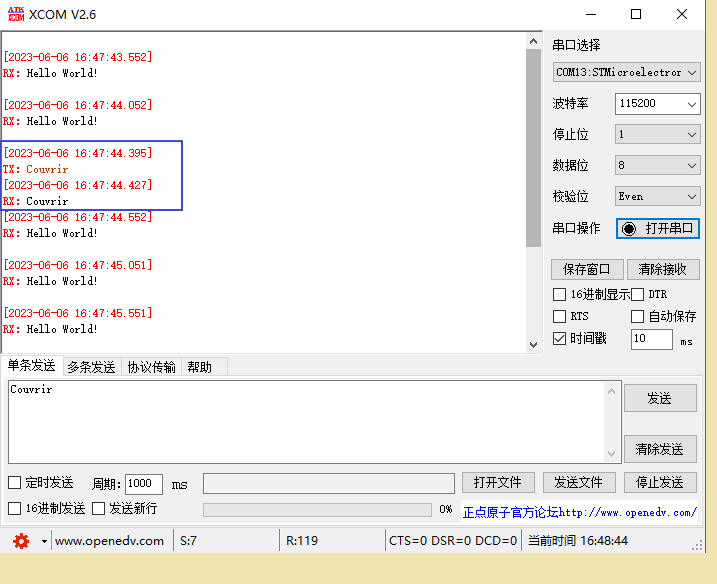
實驗環節:列印重定向
在usbd_cdc_if.c中(擷取片段,修改部分),宣告在usbd_cdc_if.h檔案。
1 /* USER CODE BEGIN PRIVATE_FUNCTIONS_IMPLEMENTATION */ 2 #include "stdarg.h" 3 #include "stdio.h" 4 5 uint8_t usbtemp[64]; 6 void usbvcom_printf(const char *format,...) 7 { 8 uint16_t len; 9 va_list args; 10 11 va_start(args, format); 12 len = vsnprintf((char *)usbtemp, sizeof(usbtemp)+1, (char *)format, args); 13 va_end(args); 14 15 CDC_Transmit_HS(usbtemp, len); 16 } 17 18 /* USER CODE END PRIVATE_FUNCTIONS_IMPLEMENTATION */
然後就可以像printf那樣使用了,實測過是正常的!
時代越來越好,開發效率越來越高,希望能幫助到你!!!
還有就是,開源萬歲。